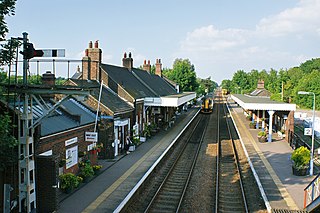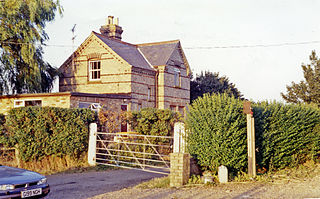
King's Lynn railway station is the northern terminus of the Fen line in the east of England, serving the town of King's Lynn, Norfolk. It is 41 miles 47 chains (66.9 km) from Cambridge and 96 miles 75 chains (156.0 km) measured from London Liverpool Street.

Wymondham railway station is on the Breckland Line in the East of England, serving the town of Wymondham, Norfolk. The line runs between Cambridge in the west and Norwich in the east. It is situated between Spooner Row and Norwich, 113 miles 72 chains (183.3 km) from London Liverpool Street via Ely.

Stoke Ferry is a closed railway station in Norfolk. It was the terminus of a 7¼ mile branch line from Denver which opened on 1 August 1882 and finally closed to all traffic in 1965.

Bungay railway station was located on the now disused Waveney Valley Line which ran between Tivetshall and Beccles. The station was closed in 1953 and the buildings eventually demolished to make way for the A143 road. It was one of two stations in Suffolk on the line, which curved across the county boundary then back into Norfolk.
Wissington in Norfolk is the site of British Sugar's largest refinery in the UK; it is also the largest in Europe. There has been a sugar factory there since 1925; however none of the rest of the village remains, other than the name. British Sugar has opened the UK's first bioethanol plant here.

The GER Class R24 was a class of 0-6-0T steams designed by James Holden for the Great Eastern Railway (GER). They passed to the London and North Eastern Railway at the grouping in 1923 and received the LNER classification J67. Some R24s were rebuilt with higher boiler pressure in which form they were similar to the later Class S56. The rebuilt R24s, together with the S56s, were classified J69 by the LNER.

Cranbrook railway station is a disused English station which was on the closed Hawkhurst Branch in Kent, England.

Abbey and West Dereham railway station was a railway station on the line between Downham Market and Stoke Ferry. It served the village of West Dereham and the nearby St Mary's Abbey, in Norfolk, England. It was located south of the village on what is still called Station Road:

Denver railway station was a station in Denver, Norfolk on the Great Eastern Railway route between King's Lynn and Cambridge, commonly known as the Fen Line. It was also the beginning of a small branch to Stoke Ferry.
Ryston railway station was a railway station serving Fordham, Norfolk. It was on a branch line from Denver.
Ingham railway station was a railway station in Ingham, Suffolk which was located was on the route between Thetford and Bury St Edmunds.

Barnham railway station is a former station in Barnham, Suffolk on a now closed line between Thetford and Bury St Edmunds. It was located close to the Norfolk border.
Seven Hills Halt railway station was a railway station in Suffolk, England on the branch line between Thetford and Bury St Edmunds. It was closed in 1953, along with the rest of the branch.

Ramsey North railway station was a railway station in Ramsey, Cambridgeshire which is now closed. It was the terminus of a branch line from Holme on the East Coast main line run by the Great Northern Railway.

The Wigan Junction Railways connected Glazebrook West Junction with the Lancashire Coalfields at Wigan.
The Wymondham to Wells Branch was a railway built in stages by the Norfolk Railway, Eastern Counties Railway and Wells and Fakenham Company between 1847 and 1857. The railway ran from Wymondham in the south, through Dereham and Fakenham to the coastal town of Wells-next-the-Sea; more specifically, the line ran from Wymondham South Junction, where it met the present-day Breckland Line. Passenger services along the line lasted until 1969; the railway continued to be used for freight until 1989. The southern section of the railway now forms the Mid-Norfolk Railway, with part of the northern section serving as the narrow gauge Wells and Walsingham Light Railway.

Redmarshall railway station was a railway station on the North Eastern Railway, in County Durham.
Thetford Bridge railway station served the eastern part of Thetford, Norfolk, England between 1875 and 1953.

The Snape branch line was a railway branch line located in Suffolk which served Snape Maltings. It ran from Snape Junction on the East Suffolk line and was 1+1⁄4 long. The line was opened in 1859 and throughout its life was operated as a freight-only line. The line was closed 101 years later in 1960.
West Auckland railway station served the villages of St Helen Auckland and West Auckland in County Durham, England, between 1833 and 1962. It was on the railway line between Bishop Auckland and Barnard Castle. There was a locomotive depot, which was the only one to be both closed completely and later reopened by the London and North Eastern Railway.












